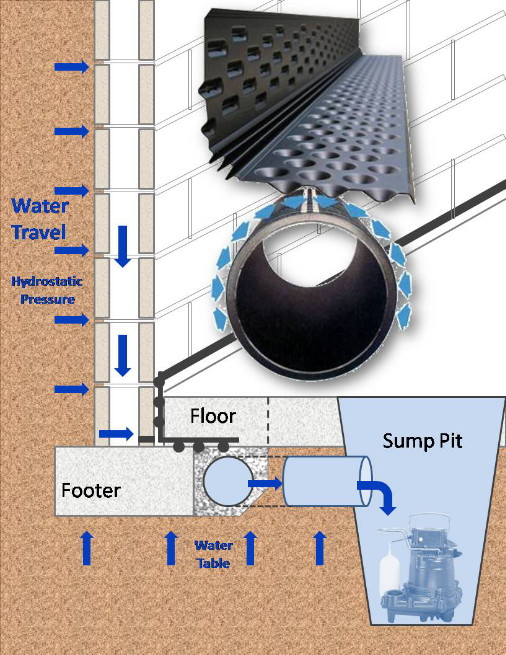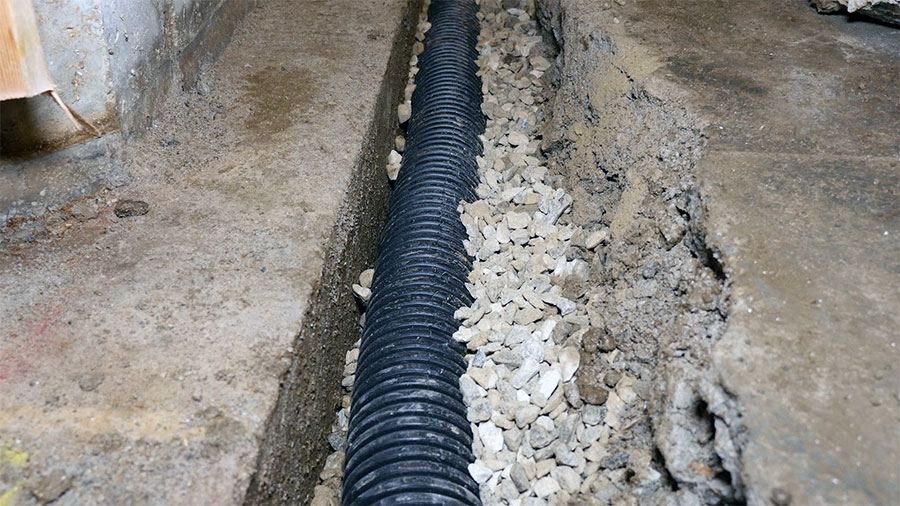Expert Tips for Caring for Your Portland French Drain
Expert Tips for Caring for Your Portland French Drain
Blog Article
The Important Overview to Preserving Your French Drain for Lasting Performance
Maintaining your French drainpipe is essential to its efficiency and your home's defense. Normal checks can conserve you from pricey fixings and water damages. You'll wish to know what indicators to try to find and exactly how commonly to evaluate your system. Plus, recognizing the cleansing process can make a significant difference. Allow's discover the essential steps for guaranteeing your drain operates well for many years ahead.
Comprehending the Function of a French Drainpipe
A French drain is an essential part in handling water around your home. It routes excess water far from your structure, preventing flooding and damages. When hefty rain falls, the drainpipe gathers water through a perforated pipe buried in crushed rock. This system permits water to stream openly, reducing stress on your basement walls and lessening the danger of leaks.You could ask yourself exactly how it functions in method. As water saturates the dirt, gravity pulls it towards the drainpipe. The perforated pipeline records this water, delivering it to a designated drain location or storm sewer. This procedure maintains your lawn dry and shields your home's architectural integrity.Understanding just how a French drainpipe features is key to valuing its importance. By properly channeling water away, it aids keep a completely dry and risk-free living environment. Maintaining your French drainpipe in leading condition guarantees you prevent pricey repairs down the line.
Regular Inspections: What to Try to find
When you're examining your French drainpipe, begin by examining for any obstructions that may be obstructing water circulation. Focus on indications of surface area disintegration around the drain, as this can suggest potential problems. Normal analyses will certainly help maintain your water drainage system operating properly.
Obstructed Drain Evaluation
Just how can you tell if your French drainpipe is obstructed? Initially, look for water merging in your yard, specifically after hefty rainfall. That's a red flag if you discover areas where water gathers rather of draining. You need to likewise inspect the drainpipe outlet; if water isn't spurting as it should, there's most likely a clog. Listen for unusual gurgling sounds, which can show trapped air. Furthermore, evaluate the drainpipe's surface area for any greenery development, as origins can obstruct the system and infiltrate. Finally, if you scent mildewy odors, it can indicate stagnant water created by an obstruction. On a regular basis examining these indications can assist you keep your French drainpipe effectively and prevent expensive repairs.
Surface Disintegration Examine

Cleansing Your French Drainpipe: Step-by-Step Overview
Cleaning your French drain is important for keeping it operating appropriately. You'll need some specific tools and a clear process to assure everything runs smoothly. Allow's go through the actions and suggestions for maintaining your drainpipe successfully.
Devices You'll Need
To take on the job of cleansing your French drainpipe effectively, you'll intend to collect a couple of crucial tools. Get hold of a durable set of handwear covers to protect your hands from particles and sharp things. A little shovel or trowel will certainly assist you get rid of dirt or obstructions around the drainpipe. For removing the interior, a plumbing technician's serpent or a high-pressure water nozzle can be extremely valuable. You'll also need a container for collecting any type of particles you take out. Having a garden hose on hand will certainly make it less complicated to wash out the drainpipe and guarantee it's moving smoothly. With these tools ready, you'll be set for a thorough cleansing session!
Cleansing Refine Steps
Beginning by evaluating the area around your French drainpipe for any noticeable debris or clogs. Get rid of fallen leaves, branches, or dust that might block water circulation. Next, inspect the inlet and electrical outlet locations; clear any type of obstructions to assure appropriate drain. Make use of a garden hose pipe to purge the drainpipe, routing water right into the inlet. This helps dislodge any type of accumulated sludge or debris. Think about using a plumber's snake to damage them up if you observe consistent clogs. After cleansing, check the crushed rock around the drain; replenish it if it's cleaned away. Verify the drain covers are undamaged and securely in location to protect against debris from getting in. Routine cleansing maintains your French drainpipe functioning efficiently.
Maintenance Frequency Tips
While regular maintenance is crucial for your French drainpipe's durability, understanding just how often to keep it can make all the distinction. Preferably, you should check your French drain a minimum of two times a year, ideally in springtime and loss. After heavy rainfall or snowmelt, look for obstructions or debris. If you discover any kind of standing water, it's time to clean your drain.In areas with heavy foliage, even more regular upkeep-- about every 3 months-- may be required. In addition, consider cleansing your French drainpipe after major tornados or if you observe water pooling in your yard. By remaining aggressive, you'll ensure your French drain functions properly and protects your residential property from water damage. Routine checks will certainly save you money and time over time.
Recognizing Usual Problems and Their Solutions
It's essential to identify typical problems with your French drainpipe and carry out efficient options when you see water pooling in your lawn or damp areas in your cellar. One regular issue is clogging, often brought on by debris like fallen leaves or sediment. To repair this, you can utilize a plumbing snake or a high-pressure water jet to clear blockages.Another problem could be incorrect slope. If your drain isn't sloped properly, water won't move far from your home. You can readjust the incline by digging and repositioning the drain pipe.Lastly, look for damage or see here now cracks in the drain itself. If you discover any type of, replacing the harmed sections is very important for peak performance. By resolving these concerns immediately, you'll help ensure that your French drain proceeds to function efficiently, securing your residential property from water damages and maintaining a completely dry, secure setting.
Seasonal Maintenance Tips for Your French Drainpipe
Attending to usual issues with your French drain is simply the primary step in assuring its long-lasting performance. Seasonal upkeep is essential for peak performance. In the spring, remove leaves and particles that might have gathered throughout wintertime. Examine for any obstructions in the outlet or capture basin, as water needs a clear course to flow freely.During summer, examine your drain for any kind of signs of working out or shifting soil. Ensure it's still degree and working correctly. As fall strategies, clean out any kind of fallen entrusts to prevent blockages before wintertime arrives.In winter, watch for freezing temperature levels. If you reside in a cold climate, make certain your drainpipe isn't at danger of freezing. Shielding revealed pipelines can help. Regular checks and timely maintenance can prevent costly repair services and keep your French drain working properly year-round. Stay positive and appreciate assurance recognizing your drain system remains in great shape!
When to Call a Specialist
Understanding when to employ a professional can save you time and avoid additional damages to your French drain. It's a clear indication that your drain might be obstructed or damaged if you notice consistent standing water in your yard. Do not neglect strange odors, as they can show sewer backup or decay, which calls for prompt attention.If you find that your drainpipe isn't operating effectively after efforts to tidy or maintain it, it's time to get to out for specialist help. Additionally, if you're not sure regarding the underlying issues or lack the necessary devices, employing a professional can provide tranquility of mind.Finally, if your French drainpipe is old or has actually experienced substantial wear and tear, expert assessment can figure out whether fixings or total substitute is required. Trust the professionals to guarantee your water drainage system functions effectively for several years to find.
Tips for Stopping Future Drainage Problems
To maintain your French drain functioning efficiently, routinely inspecting and maintaining it can make all the distinction. Begin by clearing particles, leaves, and dust from the surface and drainpipe openings. This prevents clogs that can bring about water back-up. Check the crushed rock around the drain; if it's compacted or eroded, take into consideration including fresh gravel to keep optimal flow.Next, divert water far from your drainpipe by ensuring seamless gutters and downspouts are clear and routing water at the very least 3 feet far from your foundation. Consistently inspect for any type of indications of damage or drooping. If you discover issues, address them immediately.Finally, consider setting up a catch or a filter container to catch bigger particles before it goes into the drain. By staying aggressive with these ideas, you'll lessen the danger of future drainage troubles and maintain your French drainpipe in top form.
Regularly Asked Concerns
How much time Does a French Drain Typically Last?
A French drain generally lasts around 30 to 40 years, depending upon linked here the products used and upkeep (Portland French Drain). If you stay up to date with routine checks, you can prolong its life-span even further
Can I Mount a French Drainpipe Myself?
Yes, you can mount a French drainpipe on your own if you've got the right devices and understanding. Simply make sure to prepare thoroughly, adhere to local laws, and assurance proper water drainage to prevent future problems.
What Products Are Used in a French Drain?
You'll need perforated pipe, gravel, landscape fabric, and a solid water drainage pipe for your French drainpipe. These products aid reroute water successfully, stopping flooding and maintaining your residential property risk-free and completely dry from water damage.

Is a Permit Required to Set Up a French Drain?
You'll likely need an authorization to install a French drain, relying on neighborhood guidelines. Get in touch with your district to assure you here follow any type of necessary guidelines and avoid potential concerns during installment.
What Are the Expenses Connected With French Drain Upkeep?
Maintaining a French drainpipe typically sets you back in between $100 and $500 yearly. You'll need to take into consideration expenditures for cleansing, fixings, and inspections. Regular upkeep aids protect against bigger assurances and expenses your system works properly for years - Portland French Drain. When you're examining your French drain, start by checking for any type of clogs that might be obstructing water circulation. By staying positive, you'll assure your French drainpipe features successfully and protects your building from water damages. When you observe water merging in your lawn or damp areas in your cellar, it's crucial to identify usual issues with your French drainpipe and apply reliable solutions. You can readjust the slope by digging and repositioning the drain pipe.Lastly, check for damages or cracks in the drain itself. Check the gravel around the drainpipe; if it's compacted or eroded, take into consideration including fresh gravel to keep perfect flow.Next, draw away water away from your drainpipe by ensuring downspouts and rain gutters are clear and directing water at least 3 feet away from your structure
Report this page